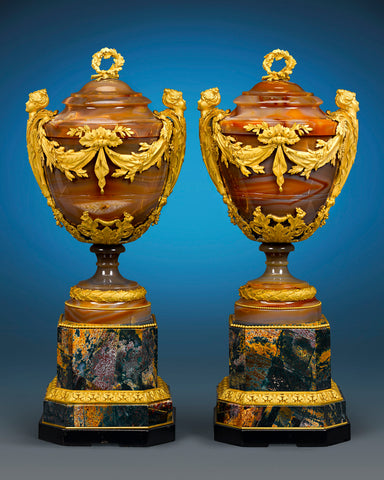M.S. Rau is committed to offering fine art of the highest caliber and we seek paintings and sculpture by historically renowned artists, often with impressive provenance. The large majority of our works of art come from private. . .
At M.S. Rau, we are committed to building a long-term, rewarding relationship with each and every client. That’s why your purchase is backed by our 125% guarantee.
Learn MorePair of Russian Malachite Tazze by the Imperial Lapidary Works
- This pair of malachite tazze is a magnificent example of early 19th-century Russian craftsmanship
- They exemplify the period when malachite emerged as the principal decorative material in Russia
- Each tazza features a classical silhouette and is veneered in concentric stalactitic malachite
- The Imperial Lapidary Works played a central role in establishing malachite as a national treasure
- Get complete item description here
To speak to one of our experts, call 1-888-711-8084
Imperial Lapidary Works
Circa 1830
A magnificent example of early 19th-century Russian craftsmanship, this pair of malachite tazze was created by the Imperial Lapidary Works of Ekaterinburg, circa 1830. These works exemplify the period when malachite emerged as the principal decorative material in Russian hardstone objects. Their form and execution closely relate to the refined designs of Ivan Ivanovich Galberg, the most prolific designer of hardstone pieces in Russia. . .
Imperial Lapidary Works
Circa 1830
A magnificent example of early 19th-century Russian craftsmanship, this pair of malachite tazze was created by the Imperial Lapidary Works of Ekaterinburg, circa 1830. These works exemplify the period when malachite emerged as the principal decorative material in Russian hardstone objects. Their form and execution closely relate to the refined designs of Ivan Ivanovich Galberg, the most prolific designer of hardstone pieces in Russia during this period.
Each tazza features a clean, classical silhouette and is veneered in vivid concentric stalactitic malachite, one of the most prized varieties of the stone. The surfaces are executed in the distinctive Russian mosaic technique, perfected by Russian craftsmen, where thin slices of malachite are sorted by pattern and seamlessly applied with powdered malachite paste. Their design is very similar to a Galberg model presented as a diplomatic gift to the Duke of Wellington in 1826.
Founded in 1751 in the Ural Mountains, the Imperial Lapidary Works played a central role in establishing malachite as a national treasure in Russia. The stone’s rise to prominence followed the discovery of rich deposits near Ekaterinburg and Nizhnii Tagil in the 1810s–30s, leading to its use in major commissions, including the celebrated Malachite Room of the Winter Palace. Elegant and technically superb, this pair of tazze represents the pinnacle of early 19th-century Russian stone-cutting and design.
Each: 9 3/8" high x 7 1/2" diameter

| Period: | 19th Century |
| Origin: | Russia |
| Type: | Vases/Vessels |
| Style: | Neoclassical |
| Depth: | 7.5 in. (19.05 cm) |
| Width: | 7.5 in. (19.05 cm) |
| Height: | 9.38 in. (23.81 cm) |

A Closer Look at Russian Decorative Arts
Russia has been a hub of artistic development for over 500 years. Beginning in the 17th century, Tsar Peter the Great led a colossal cultural revolution that aligned the country with the political,...
Read More
Your Guide to Decorating with Antiques
From foyers to living rooms, read our guide and expert tips on how to decorate your home with antiques. Whether it be daring or contemplative, grand or an accent piece, antique furniture and...
Read MoreAt M.S. Rau, we are committed to building a long-term, rewarding relationship with each and every client. That’s why your purchase is backed by our 125% guarantee.
Learn More











